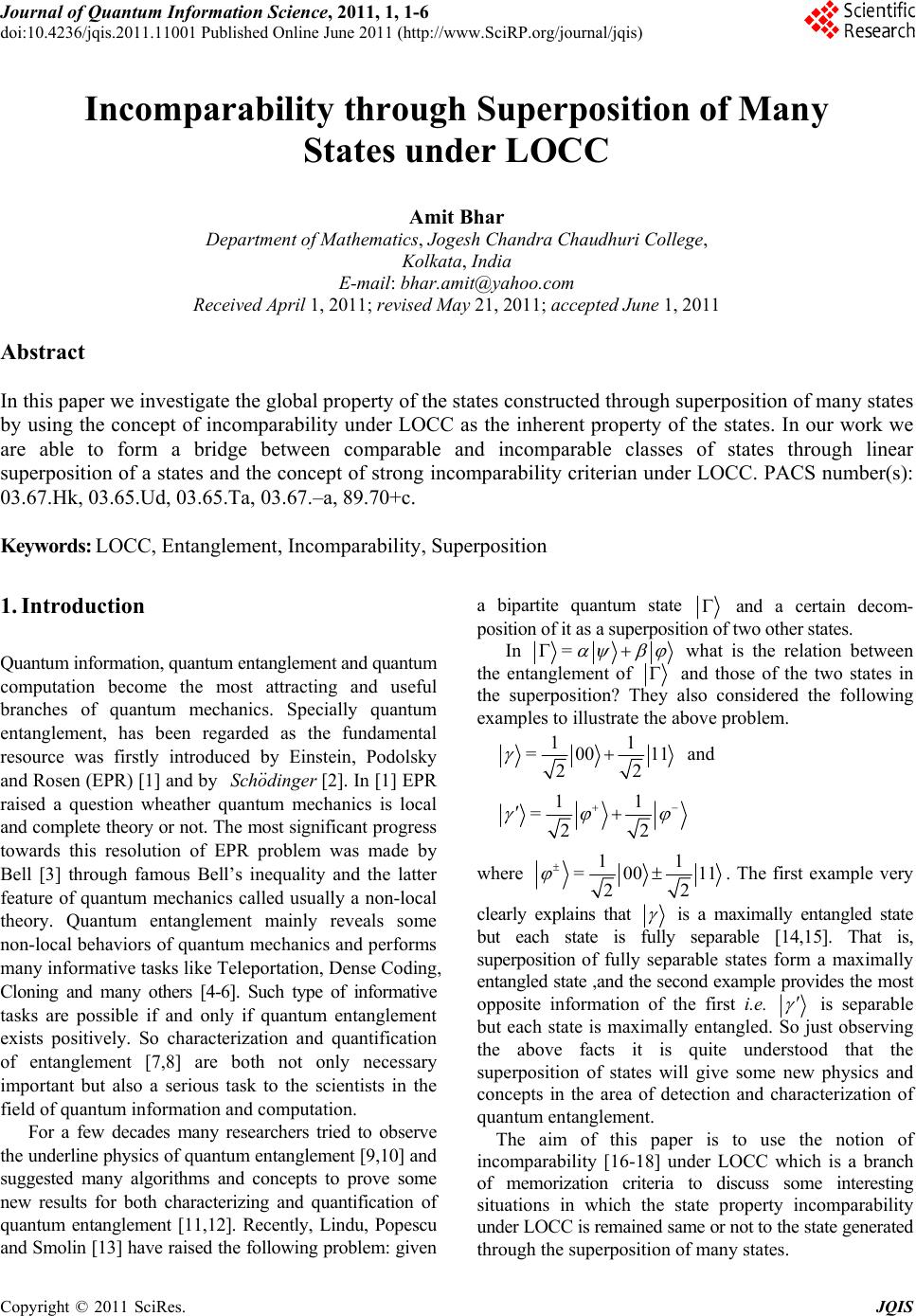 Journal of Quantum Informatio n Science, 2011, 1, 1-6 doi:10.4236/jqis.2011.11001 Published Online June 2011 (http://www.SciRP.org/journal/jqis) Copyright © 2011 SciRes. JQIS Incomparability through Superposition of Many States under LOCC Amit Bhar Department of Mat hematics, Jogesh Chandra Chaudhuri College, Kolkata, India E-mail: bhar.amit@yahoo.com Received April 1, 2011; revised May 21, 2011; accept ed J un e 1, 2011 Abstract In this paper we investigate the global property of the states constructed through superposition of many states by using the concept of incomparability under LOCC as the inherent property of the states. In our work we are able to form a bridge between comparable and incomparable classes of states through linear superposition of a states and the concept of strong incomparability criterian under LOCC. PACS number(s): 03.67.Hk, 03.65.Ud, 03.65.Ta, 03.67.–a, 89.70+c. Keywords: LOCC, Entanglement, Incomparability, Superposition 1. Introduction Quantum information, quantum entanglement and quantum computation become the most attracting and useful branches of quantum mechanics. Specially quantum entanglement, has been regarded as the fundamental resource was firstly introduced by Einstein, Podolsky and Rosen (EPR) [1] and by dingeroSch [2]. In [1] EPR raised a question wheather quantum mechanics is local and complete theory or not. The most significant progress towards this resolution of EPR problem was made by Bell [3] through famous Bell’s inequality and the latter feature of quantum mechanics called usually a non-local theory. Quantum entanglement mainly reveals some non-local behaviors of quantum mechanics and performs many informative tasks like Teleportation, Dense Coding, Cloning and many others [4-6]. Such type of informative tasks are possible if and only if quantum entanglement exists positively. So characterization and quantification of entanglement [7,8] are both not only necessary important but also a serious task to the scientists in the field of quantum information and computation. For a few decades many researchers tried to observe the underline physics of quantum entanglement [9,10] and suggested many algorithms and concepts to prove some new results for both characterizing and quantification of quantum entanglement [11,12]. Recently, Lindu, Popescu and Smolin [13] have raised the following problem: given a bipartite quantum state and a certain decom- position of it as a superposition of two other states. In = what is the relation between the entanglement of and those of the two states in the superposition? They also considered the following examples to illustrate the above problem. 11 =00 11 22 and 11 =22 where 11 =00 11 22 . The first example very clearly explains that is a maximally entangled state but each state is fully separable [14,15]. That is, superposition of fully separable states form a maximally entangled state ,and the second example provides the most opposite information of the first i.e. is separable but each state is maximally entangled. So just observing the above facts it is quite understood that the superposition of states will give some new physics and concepts in the area of detection and characterization of quantum entanglement. The aim of this paper is to use the notion of incomparability [16-18] under LOCC which is a branch of memorization criteria to discuss some interesting situations in which the state property incomparability under LOCC is remained same or not to the state generated through the superposition of many states. 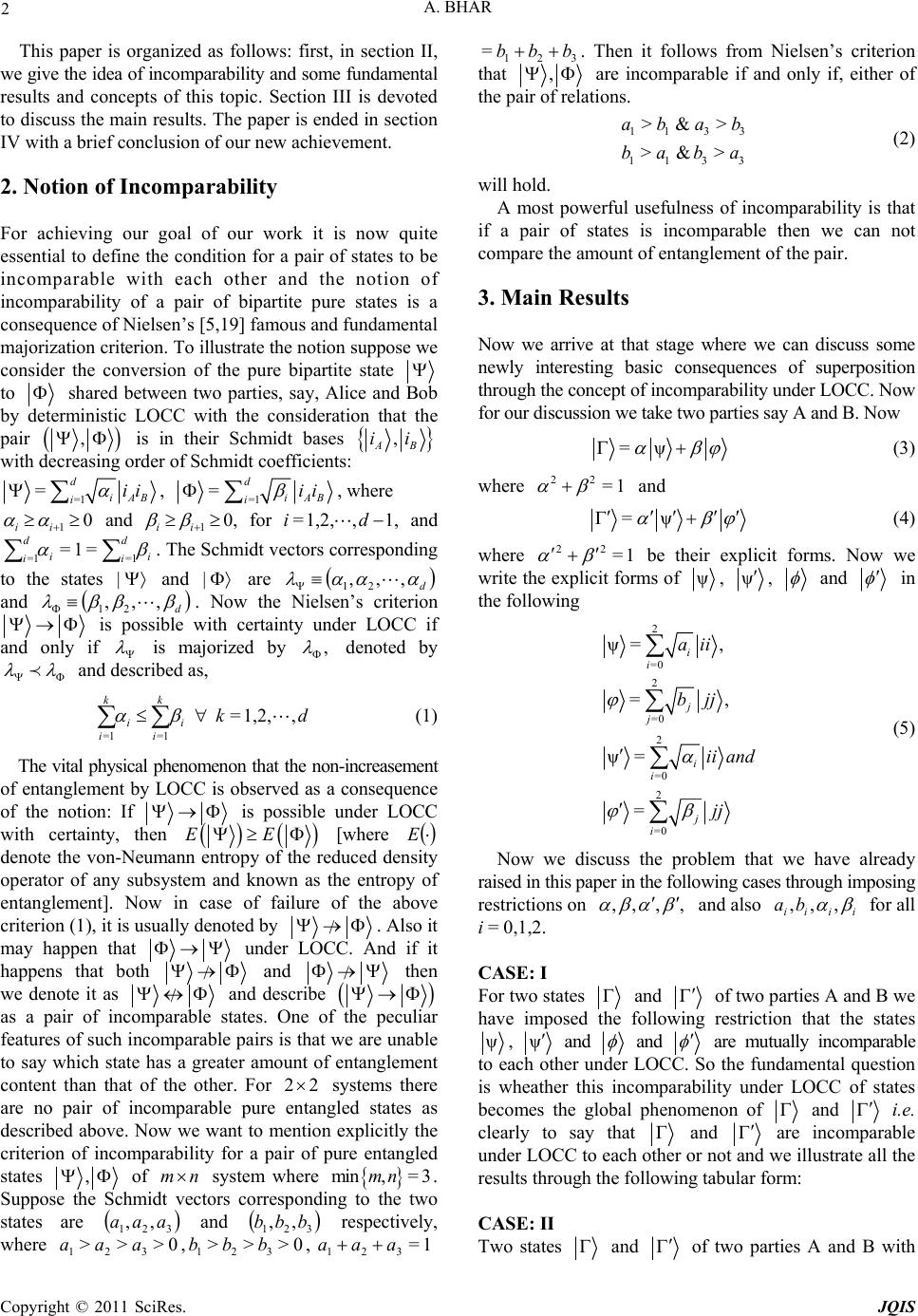 A. BHAR Copyright © 2011 SciRes. JQIS 2 This paper is organized as follows: first, in section II, we give the idea of incomparability and some fundamental results and concepts of this topic. Section III is devoted to discuss the main results. The paper is ended in section IV with a brief conclusion of our new achievement. 2. Notion of Incomparability For achieving our goal of our work it is now quite essential to define the condition for a pair of states to be incomparable with each other and the notion of incomparability of a pair of bipartite pure states is a consequence of Nielsen’s [5,19] famous and fundamental majorization criterion. To illustrate the notion suppose we consider the conversion of the pure bipartite state to shared between two parties, say, Alice and Bob by deterministic LOCC with the consideration that the pair , is in their Schmidt bases , AB ii with decreasing order of Schmidt coefficients: =1 =d iAB iii , =1 =d iAB iii , where 0 1 ii and 0, 1 ii for 1,,1,2,= di and i d i i d i 1=1= =1= . The Schmidt vectors corresponding to the states | and | are d ,,, 21 and d ,,, 21 . Now the Nielsen’s criterion is possible with certainty under LOCC if and only if is majorized by , denoted by and described as, dk i k i i k i ,1,2,= 1=1= (1) The vital physical phenomenon that the non-increasement of entanglement by LOCC is observed as a consequence of the notion: If is possible under LOCC with certainty, then EE [where E denote the von-Neumann entropy of the reduced density operator of any subsystem and known as the entropy of entanglement]. Now in case of failure of the above criterion (1), it is usually denoted by . Also it may happen that under LOCC. And if it happens that both and then we denote it as and describe as a pair of incomparable states. One of the peculiar features of such incomparable pairs is that we are unable to say which state has a greater amount of entanglement content than that of the other. For 22 systems there are no pair of incomparable pure entangled states as described above. Now we want to mention explicitly the criterion of incomparability for a pair of pure entangled states , of nm system where min,= 3mn . Suppose the Schmidt vectors corresponding to the two states are 321,,aaa and 321 ,, bbb respectively, where , 0>>> , 0>>>321321bbbaaa 1= 321aaa 321 =bbb . Then it follows from Nielsen’s criterion that , are incomparable if and only if, either of the pair of relations. 113 3 11 3 3 >& > >&> abab baba (2) will hold. A most powerful usefulness of incomparability is that if a pair of states is incomparable then we can not compare the amount of entanglement of the pair. 3. Main Results Now we arrive at that stage where we can discuss some newly interesting basic consequences of superposition through the concept of incomparability under LOCC. Now for our discussion we take two parties say A and B. Now =ψ (3) where 22 =1 and =ψ (4) where 1= 22 be their explicit forms. Now we write the explicit forms of ψ, ψ, and in the following 2 =0 2 =0 2 =0 2 =0 ψ=, =, ψ= = i i j j i i j i aii bjj ii and jj (5) Now we discuss the problem that we have already raised in this paper in the following cases through imposing restrictions on ,,,, and also iiii ba ,,, for all i = 0,1,2. CASE: I For two states and of two parties A and B we have imposed the following restriction that the states ψ, ψ and and are mutually incomparable to each other under LOCC. So the fundamental question is wheather this incomparability under LOCC of states becomes the global phenomenon of and i.e. clearly to say that and are incomparable under LOCC to each other or not and we illustrate all the results through the following tabular form: CASE: II Two states and of two parties A and B with 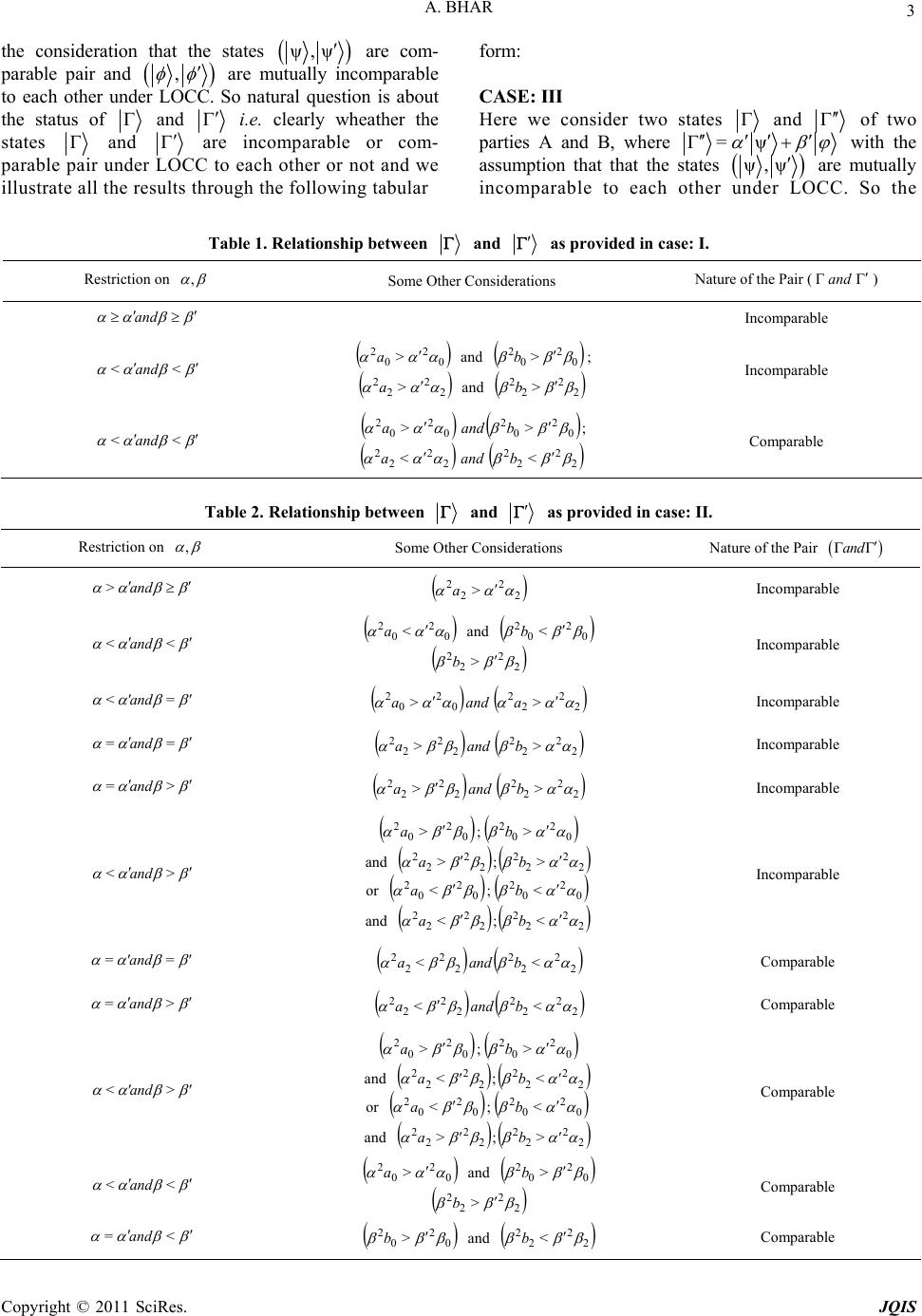 A. BHAR Copyright © 2011 SciRes. JQIS 3 the consideration that the states ψ,ψ are com- parable pair and , are mutually incomparable to each other under LOCC. So natural question is about the status of and i.e. clearly wheather the states and are incomparable or com- parable pair under LOCC to each other or not and we illustrate all the results through the following tabular form: CASE: III Here we consider two states and of two parties A and B, where =ψ with the assumption that that the states ψ,ψ are mutually incomparable to each other under LOCC. So the Table 1. Relationship between and as provided in case: I. Restriction on , Some Other Considerations Nature of the Pair ( and ) and Incomparable << and 0 2 0 2> a and 0 2 0 2> b; 2 2 2 2> a and 2 2 2 2> b Incomparable << and 0 2 0 2 0 2 0 2>> banda ; 2 2 2 2 2 2 2 2<< banda Comparable Table 2. Relationship between and as provided in case: II. Restriction on , Some Other Considerations Nature of the Pair and and > 2 2 2 2> a Incomparable << and 0 2 0 2< a and 0 2 0 2< b 2 2 2 2> b Incomparable =< and 2 2 2 2 0 2 0 2>> aanda Incomparable == and 2 2 2 2 2 2 2 2>> banda Incomparable >= and 2 2 2 2 2 2 2 2>> banda Incomparable >< and 0 2 0 2> a; 0 2 0 2> b and 2 2 2 2 2 2 2 2>;> ba or 0 2 0 2< a; 0 2 0 2< b and 2 2 2 2 2 2 2 2<;< ba Incomparable == and 2 2 2 2 2 2 2 2<< banda Comparable >= and 2 2 2 2 2 2 2 2<< banda Comparable >< and 0 2 0 2> a; 0 2 0 2> b and 2 2 2 2 2 2 2 2<;< ba or 0 2 0 2< a; 0 2 0 2< b and 2 2 2 2 2 2 2 2>;> ba Comparable << and 0 2 0 2> a and 0 2 0 2> b 2 2 2 2> b Comparable <=and 0 2 0 2> b and 2 2 2 2< b Comparable 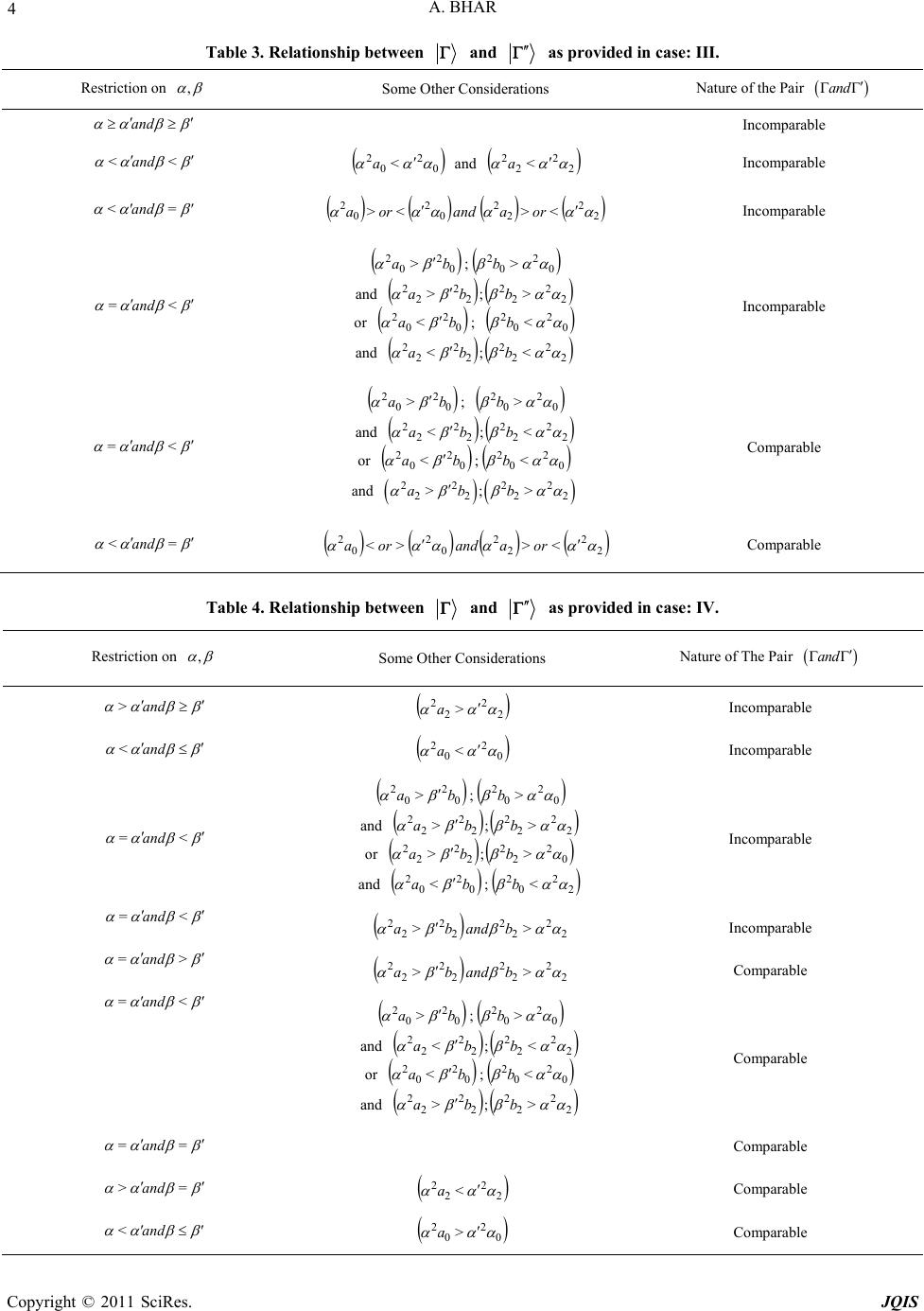 A. BHAR Copyright © 2011 SciRes. JQIS 4 Table 3. Relationship betwee n and as provided in case: III. Restriction on , Some Other Considerations Nature of the Pair and and Incomparable << and 0 2 0 2< a and 2 2 2 2< a Incomparable =< and 2 2 2 2 0 2 0 2<><> oraandora Incomparable <= and 0 2 0 2>ba ; 0 2 0 2> b and 2 2 2 2 2 2 2 2>;> bba or 0 2 0 2<ba ; 0 2 0 2< b and 2 2 2 2 2 2 2 2<;< bba Incomparable <= and 0 2 0 2>ba ; 0 2 0 2> b and 2 2 2 2 2 2 2 2<;< bba or 0 2 0 2<ba ; 0 2 0 2< b and 2222 2222 >;>abb Comparable =< and 2 2 2 2 0 2 0 2<>>< oraandora Comparable Table 4. Relationship betwee n and as provided in case: IV. Restriction on , Some Other Considerations Nature of The Pair and and > 2 2 2 2> a Incomparable and < 0 2 0 2< a Incomparable <=and 0 2 0 2>ba ; 0 2 0 2> b and 2 2 2 2 2 2 2 2>;> bba or 0 2 2 2 2 2 2 2>;> bba and 0 2 0 2<ba ; 2 2 0 2< b Incomparable <=and 2 2 2 2 2 2 2 2>> bandba Incomparable >= and 2 2 2 2 2 2 2 2>> bandba Comparable <= and 0 2 0 2>ba ; 0 2 0 2> b and 2 2 2 2 2 2 2 2<;< bba or 0 2 0 2<ba ; 0 2 0 2< b and 2 2 2 2 2 2 2 2>;> bba Comparable == and Comparable => and 2 2 2 2< a Comparable and < 0 2 0 2> a Comparable 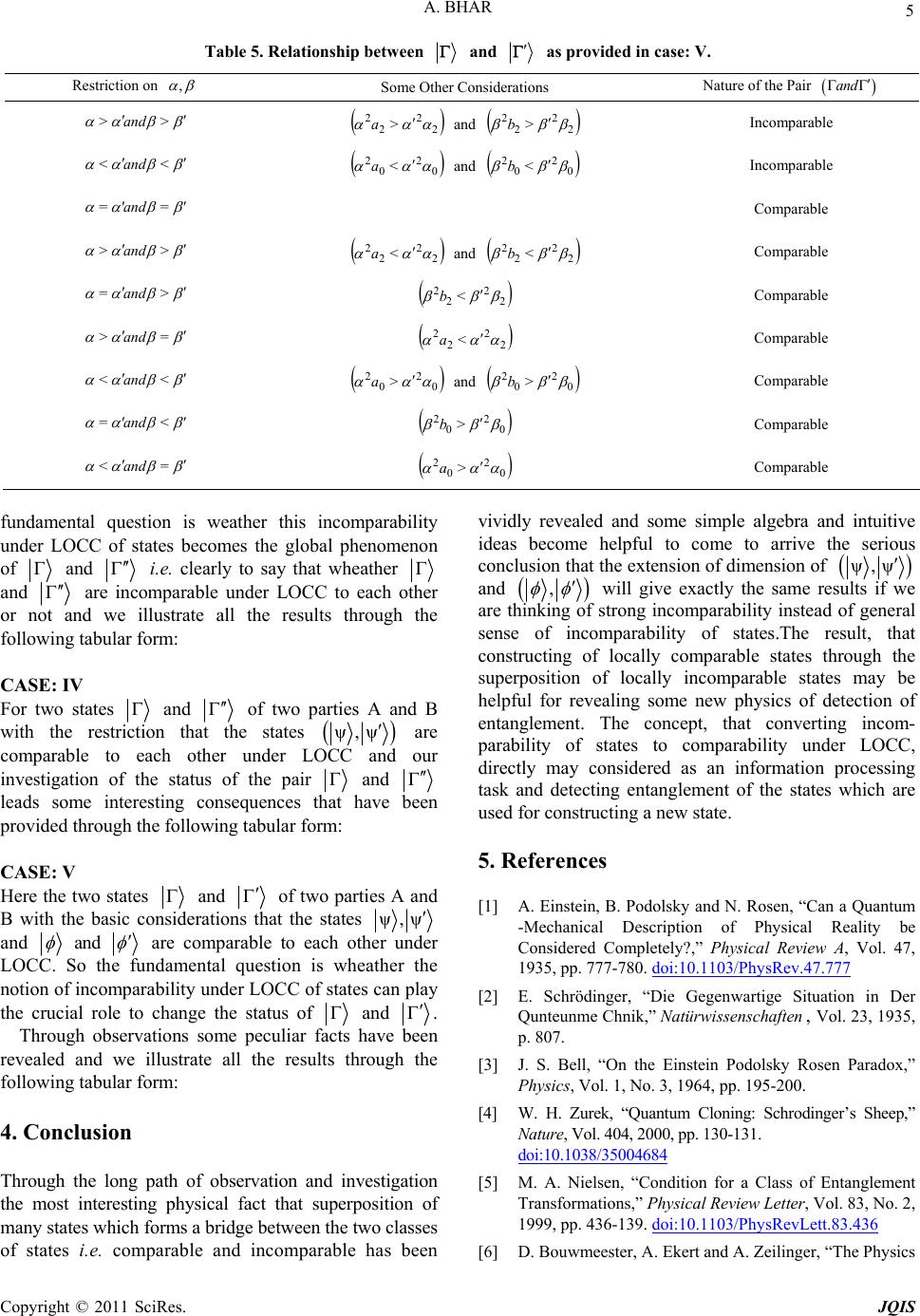 A. BHAR Copyright © 2011 SciRes. JQIS 5 Table 5. Relationship between and as provided in case: V. Restriction on , Some Other Considerations Nature of the Pair and >> and 2 2 2 2> a and 2 2 2 2> b Incomparable << and 0 2 0 2< a and 0 2 0 2< b Incomparable == and Comparable >> and 2 2 2 2< a and 2 2 2 2< b Comparable >= and 2 2 2 2< b Comparable => and 2 2 2 2< a Comparable << and 0 2 0 2> a and 0 2 0 2> b Comparable <= and 0 2 0 2> b Comparable =< and 0 2 0 2> a Comparable fundamental question is weather this incomparability under LOCC of states becomes the global phenomenon of and i.e. clearly to say that wheather and are incomparable under LOCC to each other or not and we illustrate all the results through the following tabular form: CASE: IV For two states and of two parties A and B with the restriction that the states ψ,ψ are comparable to each other under LOCC and our investigation of the status of the pair and leads some interesting consequences that have been provided through the following tabular form: CASE: V Here the two states and of two parties A and B with the basic considerations that the states ψ,ψ and and are comparable to each other under LOCC. So the fundamental question is wheather the notion of incomparability under LOCC of states can play the crucial role to change the status of and . Through observations some peculiar facts have been revealed and we illustrate all the results through the following tabular form: 4. Conclusion Through the long path of observation and investigation the most interesting physical fact that superposition of many states which forms a bridge between the two classes of states i.e. comparable and incomparable has been vividly revealed and some simple algebra and intuitive ideas become helpful to come to arrive the serious conclusion that the extension of dimension of ψ,ψ and , will give exactly the same results if we are thinking of strong incomparability instead of general sense of incomparability of states.The result, that constructing of locally comparable states through the superposition of locally incomparable states may be helpful for revealing some new physics of detection of entanglement. The concept, that converting incom- parability of states to comparability under LOCC, directly may considered as an information processing task and detecting entanglement of the states which are used for constructing a new state. 5. References [1] A. Einstein, B. Podolsky and N. Rosen, “Can a Quantum -Mechanical Description of Physical Reality be Considered Completely?,” Physical Review A, Vol. 47, 1935, pp. 777-780. doi:10.1103/PhysRev.47.777 [2] E. Schrödinger, “Die Gegenwartige Situation in Der Qunteunme Chnik,” aturwissenschaften , Vol. 23, 1935, p. 807. [3] J. S. Bell, “On the Einstein Podolsky Rosen Paradox,” Physics, Vol. 1, No. 3, 1964, pp. 195-200. [4] W. H. Zurek, “Quantum Cloning: Schrodinger’s Sheep,” Nature, Vol. 404, 2000, pp. 130-131. doi:10.1038 /3 500 468 4 [5] M. A. Nielsen, “Condition for a Class of Entanglement Transformations,” Physical Review Letter, Vol. 83, No. 2, 1999, pp. 436-139. doi:10.1103/PhysRevLett.83.436 [6] D. Bouwmeester, A. Ekert and A. Zeilinger, “The Physics 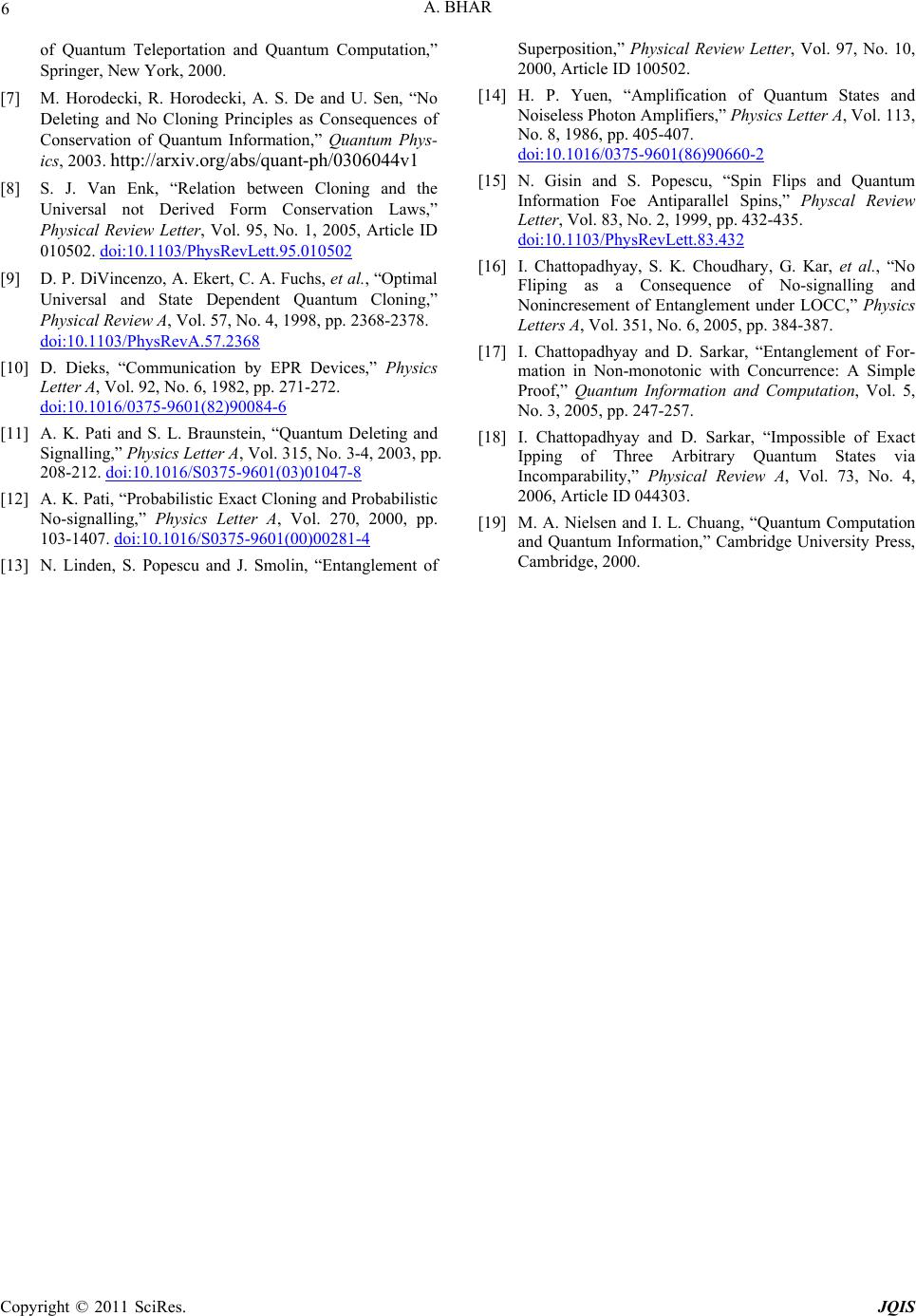 A. BHAR Copyright © 2011 SciRes. JQIS 6 of Quantum Teleportation and Quantum Computation,” Springer, New York, 2000. [7] M. Horodecki, R. Horodecki, A. S. De and U. Sen, “No Deleting and No Cloning Principles as Consequences of Conservation of Quantum Information,” Quantum Phys- ics, 2003. http://arxiv.org/abs/quant-ph/0306044v1 [8] S. J. Van Enk, “Relation between Cloning and the Universal not Derived Form Conservation Laws,” Physical Review Letter, Vol. 95, No. 1, 2005, Article ID 010502. doi:10.1103/PhysRevLett.95.010502 [9] D. P. DiVincenzo, A. Ekert, C. A. Fuchs, et al., “Optimal Universal and State Dependent Quantum Cloning,” Physical Review A, Vol. 57, No. 4, 1998, pp. 2368-2378. doi:10.1103/PhysRevA.57.2368 [10] D. Dieks, “Communication by EPR Devices,” Physics Letter A, Vol. 92, No. 6, 1982, pp. 271-272. doi:10.1016/0375-9601(82)90084-6 [11] A. K. Pati and S. L. Braunstein, “Quantum Deleting and Signalling,” Physics Letter A, Vol. 315, No. 3-4, 2003, pp. 208-212. doi:10.1016/S0375-9601(03)01047-8 [12] A. K. Pati, “Probabilistic Exact Cloning and Probabilistic No-signalling,” Physics Letter A, Vol. 270, 2000, pp. 103-1407. doi:10.1016/S0375-9601(00)00281-4 [13] N. Linden, S. Popescu and J. Smolin, “Entanglement of Superposition,” Physical Review Letter, Vol. 97, No. 10, 2000, Article ID 100502. [14] H. P. Yuen, “Amplification of Quantum States and Noiseless Photon Amplifiers,” Physics Letter A, Vol. 113, No. 8, 1986, pp. 405-407. doi:10.1016/0375-9601(86)90660-2 [15] N. Gisin and S. Popescu, “Spin Flips and Quantum Information Foe Antiparallel Spins,” Physcal Review Letter, Vol. 83, No. 2, 1999, pp. 432-435. doi:10.1103/PhysRevLett.83.432 [16] I. Chattopadhyay, S. K. Choudhary, G. Kar, et al., “No Fliping as a Consequence of No-signalling and Nonincresement of Entanglement under LOCC,” Physics Letters A, Vol. 351, No. 6, 2005, pp. 384-387. [17] I. Chattopadhyay and D. Sarkar, “Entanglement of For- mation in Non-monotonic with Concurrence: A Simple Proof,” Quantum Information and Computation, Vol. 5, No. 3, 2005, pp. 247-257. [18] I. Chattopadhyay and D. Sarkar, “Impossible of Exact Ipping of Three Arbitrary Quantum States via Incomparability,” Physical Review A, Vol. 73, No. 4, 2006, Article ID 044303. [19] M. A. Nielsen and I. L. Chuang, “Quantum Computation and Quantum Information,” Cambridge University Press, Cambridge, 2000.
|